The suburban Seattle area was (and still is) full of 5- to 10-year-old Honda Civics, and it feels like it's been that way forever. A steady supply of reliable, inexpensive, efficient, and perhaps even attractive used cars fed a serious tuner community with its own style. Forget about the Hollywood glam rock of the "Fast and Furious" franchise; the Seattle look was low and clean, varying between functional handling improvements and something that would later evolve into the stance movement. And just like the 2018 Honda Fit I drove for a week, there was a fundamental goodness to them that transcended their economy car bones.
Of course, from the fourth-generation car in 1987 up until the seventh-generation cars in 2001, all Civics had fundamentally good suspension design. It was a place that Honda spent some extra money, rather than simply fit MacPherson struts and call it a day. Not only did that mean there was good geometry to start with, there was room for the aftermarket to improve upon things significantly without having to reengineer the A-arms.
The shift linkages were also stellar, using a pair of rods instead of the cheaper cable solution — something that wouldn't last, although Honda still manages to make cable shifters feel pretty good. But the point is, Civics were cheap economy cars that managed to be a hoot to drive, and a great starting point for builds — FWD drag cars, corner carvers, or slammed cruisers. The Civic, more than any other car around here, made it possible to have a lot of fun for not a lot of money.

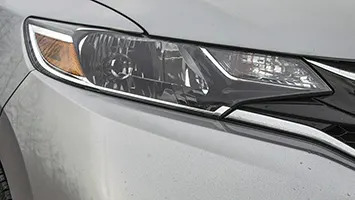

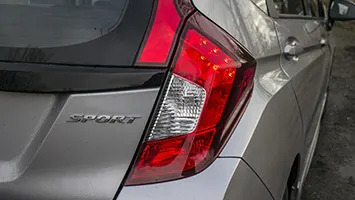
Which brings us to the Fit, which given the size increase of the Civic is probably the closest analogue to the pre-2001 Civics in the lineup. Yes, a lot has changed. There's no rod-actuated shift linkage, and it's got MacPherson struts up front with a twist-beam semi-independent rear end. That money saved is applied to things the driver can appreciate all the time, like comfy seats and a touchscreen infotainment system that would have dropped jaws in an Acura in 1998 — as well as expensive things under the skin, like airbags, a much beefier crash structure, and the 1.5-liter Earth Dreams engine.
A note about that. While some high-trim versions of the Civic got VTEC (like the D16 SOHC VTEC in EX trims, or the efficiency-oriented VTEC-E system in the HX in sixth generation Civics), the Earth Dreams engine is much more complex. Instead of multi-point port injection, the engine uses direct injection. More to the point, the valvetrain is much more complex. It's DOHC, for one, and utilizes the latest version of i-VTEC which includes continuously variable cam phasing on both the intake and exhaust cams, and also variable intake lift. These systems are expensive, as are tuning them to meet contemporary emissions and efficiency standards.
On the other hand, the 130 horsepower (at 6,600 RPM) and 114 pound-feet of torque (at 4,600 RPM) the Fit makes bests the 1996 Civic EX's once laudable figures by a fair margin. That car made 127 hp (6,600 RPM) and a measly 107 lb-ft (5,500 RPM) — and that peak torque came 900 RPM later than the Fit's. A sixth-generation coupe weighed just 2,342 pounds, while the Fit is much heavier — 2,522 pounds. Those extra pounds can be explained by the far more rigorous safety equipment requirements.

This is a very long introduction before getting to driving impressions, but I wanted to convey the many ways in which the Fit is similar, and the equally important ways that it's different, from the cars that basically made Honda's reputation in this country. To circle back around, the 1990s Civics weren't built with the conscious purpose to become enthusiast cars. They simply were built with high-quality parts that improved the experience, whether you were just puttering around town in a DX hatchback or club racing in an EX coupe. And the Fit, more than any Honda since the first-generation Fit, nails that improbable balance — imperfectly.
In basic terms, playing rough with the Fit pays off. It's undeniably slow, but that means most backroad maneuvers are sometimes full throttle affairs. The tighter the road, the more momentum you need to carry to make it out of the corner with some semblance of pace, the more it thrives. Echoes of earlier Civics resonate here — and more here than most cars on the market, which don't have to be worked this hard to be enjoyed (itself an enjoyable exercise), or aren't fun enough to incentivize being worked so hard.
The cable-operated shifter and extremely light clutch pedal become, after a small adjustment period, completely subconscious actions. Likewise, the pedal box is ideal for throttle blipping in a tight corner quickly and precisely, which helps preserve even more momentum. This is all good, because keeping the Fit moving requires a lot of shifting.
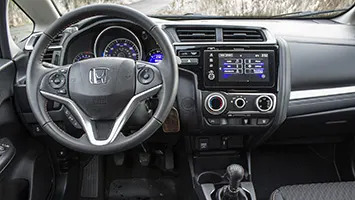


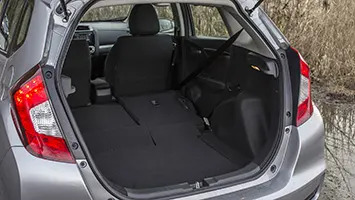
Get deep into the rhythm and you can ignore the flaws, because this isn't a mid-1990s Civic reincarnated after all. The electric steering rack has been improved from last year's design with a bearing revision, but it's still a lifeless thing that doesn't tell you much about what the front end is doing. And the stock suspension allows reasonable road-holding but without the confidence of older or better Hondas. Road imperfections cause the Fit to pitch and buck in unexpected ways — although it doesn't seem to diminish grip much. The thing to do is press on, ignoring the disconcerting body motions and numb steering, since they don't affect progress all that much.
If you're a Fit owner interested in slaloming up and down the canyons, there's a semi-aftermarket solution: HFP springs and dampers. My car wasn't so fitted, but we drove an HFP-modified Fit earlier this year, and it nails the dynamics that made old Civics so charismatic.
But even the dead stock Fit Sport I drove, with its heft and dynamic foibles, has more vintage Honda character than anything comparable — not to mention packaging efficiency and cargo-carrying abilities that are near miraculous. The tiny details, like the cupholder to the left of the steering wheel, exude an offbeat charm, too. In a market overrun with crossovers that carry less with far less charm, the Fit reminds me again of all the reasons people fell in love with Hondas in the first place.
Related Video:
Of course, from the fourth-generation car in 1987 up until the seventh-generation cars in 2001, all Civics had fundamentally good suspension design. It was a place that Honda spent some extra money, rather than simply fit MacPherson struts and call it a day. Not only did that mean there was good geometry to start with, there was room for the aftermarket to improve upon things significantly without having to reengineer the A-arms.
The shift linkages were also stellar, using a pair of rods instead of the cheaper cable solution — something that wouldn't last, although Honda still manages to make cable shifters feel pretty good. But the point is, Civics were cheap economy cars that managed to be a hoot to drive, and a great starting point for builds — FWD drag cars, corner carvers, or slammed cruisers. The Civic, more than any other car around here, made it possible to have a lot of fun for not a lot of money.




Which brings us to the Fit, which given the size increase of the Civic is probably the closest analogue to the pre-2001 Civics in the lineup. Yes, a lot has changed. There's no rod-actuated shift linkage, and it's got MacPherson struts up front with a twist-beam semi-independent rear end. That money saved is applied to things the driver can appreciate all the time, like comfy seats and a touchscreen infotainment system that would have dropped jaws in an Acura in 1998 — as well as expensive things under the skin, like airbags, a much beefier crash structure, and the 1.5-liter Earth Dreams engine.
A note about that. While some high-trim versions of the Civic got VTEC (like the D16 SOHC VTEC in EX trims, or the efficiency-oriented VTEC-E system in the HX in sixth generation Civics), the Earth Dreams engine is much more complex. Instead of multi-point port injection, the engine uses direct injection. More to the point, the valvetrain is much more complex. It's DOHC, for one, and utilizes the latest version of i-VTEC which includes continuously variable cam phasing on both the intake and exhaust cams, and also variable intake lift. These systems are expensive, as are tuning them to meet contemporary emissions and efficiency standards.
On the other hand, the 130 horsepower (at 6,600 RPM) and 114 pound-feet of torque (at 4,600 RPM) the Fit makes bests the 1996 Civic EX's once laudable figures by a fair margin. That car made 127 hp (6,600 RPM) and a measly 107 lb-ft (5,500 RPM) — and that peak torque came 900 RPM later than the Fit's. A sixth-generation coupe weighed just 2,342 pounds, while the Fit is much heavier — 2,522 pounds. Those extra pounds can be explained by the far more rigorous safety equipment requirements.

This is a very long introduction before getting to driving impressions, but I wanted to convey the many ways in which the Fit is similar, and the equally important ways that it's different, from the cars that basically made Honda's reputation in this country. To circle back around, the 1990s Civics weren't built with the conscious purpose to become enthusiast cars. They simply were built with high-quality parts that improved the experience, whether you were just puttering around town in a DX hatchback or club racing in an EX coupe. And the Fit, more than any Honda since the first-generation Fit, nails that improbable balance — imperfectly.
In basic terms, playing rough with the Fit pays off. It's undeniably slow, but that means most backroad maneuvers are sometimes full throttle affairs. The tighter the road, the more momentum you need to carry to make it out of the corner with some semblance of pace, the more it thrives. Echoes of earlier Civics resonate here — and more here than most cars on the market, which don't have to be worked this hard to be enjoyed (itself an enjoyable exercise), or aren't fun enough to incentivize being worked so hard.
The cable-operated shifter and extremely light clutch pedal become, after a small adjustment period, completely subconscious actions. Likewise, the pedal box is ideal for throttle blipping in a tight corner quickly and precisely, which helps preserve even more momentum. This is all good, because keeping the Fit moving requires a lot of shifting.




Get deep into the rhythm and you can ignore the flaws, because this isn't a mid-1990s Civic reincarnated after all. The electric steering rack has been improved from last year's design with a bearing revision, but it's still a lifeless thing that doesn't tell you much about what the front end is doing. And the stock suspension allows reasonable road-holding but without the confidence of older or better Hondas. Road imperfections cause the Fit to pitch and buck in unexpected ways — although it doesn't seem to diminish grip much. The thing to do is press on, ignoring the disconcerting body motions and numb steering, since they don't affect progress all that much.
If you're a Fit owner interested in slaloming up and down the canyons, there's a semi-aftermarket solution: HFP springs and dampers. My car wasn't so fitted, but we drove an HFP-modified Fit earlier this year, and it nails the dynamics that made old Civics so charismatic.
But even the dead stock Fit Sport I drove, with its heft and dynamic foibles, has more vintage Honda character than anything comparable — not to mention packaging efficiency and cargo-carrying abilities that are near miraculous. The tiny details, like the cupholder to the left of the steering wheel, exude an offbeat charm, too. In a market overrun with crossovers that carry less with far less charm, the Fit reminds me again of all the reasons people fell in love with Hondas in the first place.
Related Video:
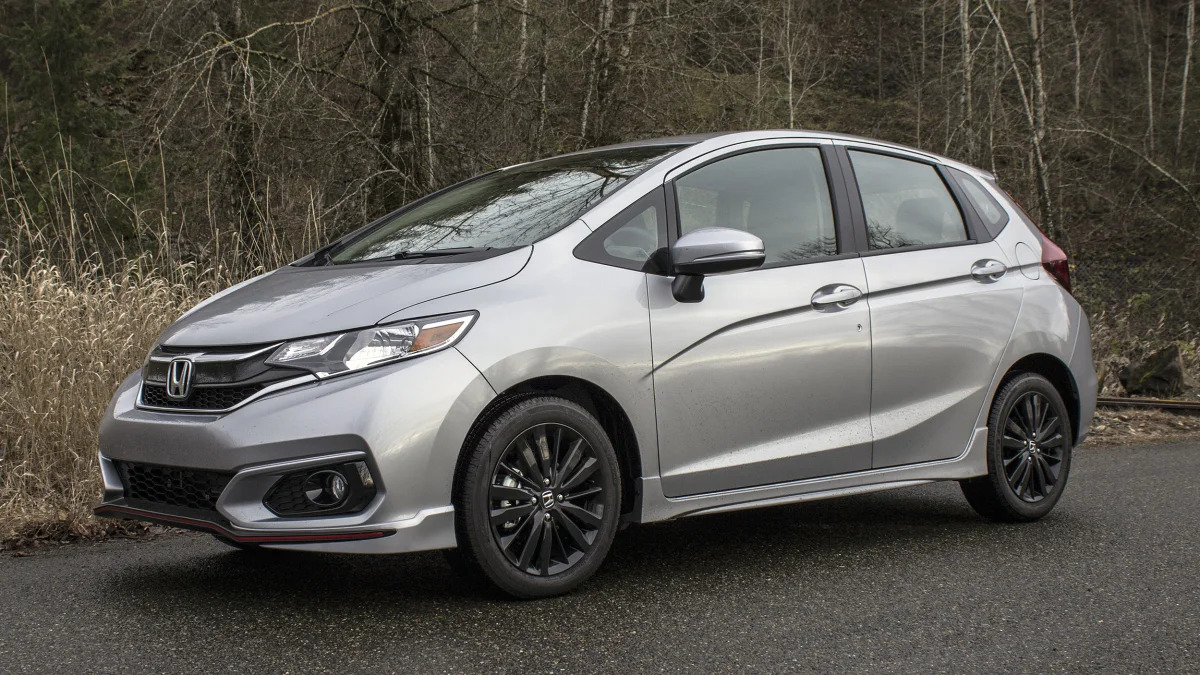









Sign in to post
Please sign in to leave a comment.
Continue